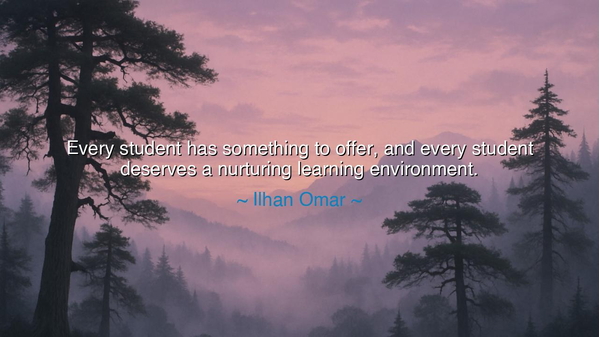
Every student has something to offer, and every student deserves
Every student has something to offer, and every student deserves a nurturing learning environment.






In the councils of old, when elders measured worth not by wealth but by wonder, they taught that a village is richest when each child is seen. Thus the saying of Ilhan Omar—“Every student has something to offer, and every student deserves a nurturing learning environment.”—rings like a bell calling us to assembly. It proclaims a double truth: that within every student lies a hidden gift, and that only in a nurturing learning environment does that gift grow into a blessing for all. The seed is already present; our task is to tend the soil.
To say every student has something to offer is to reject the silent cruelty of comparison. The hawk does not scold the river for failing to fly; the river does not mock the hawk for lacking current. One child brings quick hands and tinkering eyes; another, a steady heart that quiets a room; a third, questions sharp enough to carve new paths through old problems. The wise teacher learns to listen for each child’s music and to arrange the classroom like an orchestra, where many instruments make one song.
Yet the seed cannot grow in salt ground. The promise that every student deserves a nurturing learning environment demands more than kind words—it requires a craft of care. Nurture is not softness alone; it is structure warmed by dignity. It is the rhythm of clear expectations, the safety of patient correction, the sunlight of praise that is honest and specific. In such a place, mistakes become maps, not verdicts; effort becomes the currency of honor; curiosity is treated as a lamp to be fueled, not a nuisance to be snuffed.
Consider a true story that has traveled by word of mouth like a lantern through dark halls: Jaime Escalante, a teacher in East Los Angeles, took a roomful of “ordinary” students and taught them calculus. He did not begin with genius; he began with belief—and then built scaffolds of time, practice, and relentless encouragement. The school did not mint prodigies; it nurtured perseverance. In the warmth of that learning environment, teenagers once dismissed as statistics discovered what they had to offer: grit, logic, humor, and courage. The harvest was not only high test scores, but widened futures and a neighborhood that learned to expect more from itself.
The origin of this wisdom is older still. In the writings of Janusz Korczak, in the schools of Maria Montessori, in the kitchen-table lessons of parents teaching by lamplight, we hear the same refrain: the child is not a vessel to be filled but a fire to be kindled. A nurturing place is flint and tinder—it gives spark, shelter, and room to breathe. History’s great classrooms were not gilded; they were attentive. Their power lay in the gaze that said, “I see you,” and the practice that said, “You can.”
From this, take a clear lesson for our time: equity is not a favor; it is good stewardship. When we build rooms that protect the shy, channel the bold, welcome the newcomer, and steady the wounded, we multiply the village’s intelligence. The farmer knows this: a diverse field resists blight and yields through drought; so too a diverse classroom, where each mind strengthens the others. Deny a child the right to learn in safety and respect, and the loss is not only theirs—it is the community’s dimmer future.
And now, let counsel become action. For teachers: greet by name, assess by growth, vary the paths to mastery, and make feedback a kind mirror. For schools: design spaces where light, sound, and air favor focus; weave mentorship into the week; make art and play partners of mathematics and history. For families: ask not “What did you get?” but “What did you try?” and “What did you discover?” For leaders: fund the basics—books, quiet, nutrition—and the essentials of dignity—counselors, inclusive curricula, fair discipline. And for every student: bring your offer—your question, your story, your patience; know that you deserve to grow, and that the room can be made to help you rise. Do these things, and the proverb will cease to be an aspiration and become our daily practice: a nurturing learning environment where the many become one, and the one strengthens the many.






AAdministratorAdministrator
Welcome, honored guests. Please leave a comment, we will respond soon